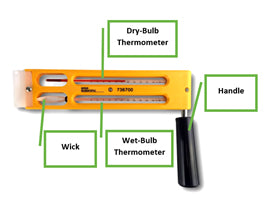If it ain’t broke, don’t fix it. Psychrometers are by no means a new invention and have barely changed in recent decades. Yet, this popular piece of scientific equipment that measures humidity is still incredibly useful and widely used today.
About Sling Psychrometers
Hygrometers measure the relative humidity of an environment. Psychrometers are battery-free hygrometers that offer a straightforward way of obtaining humidity measurements.
Psychrometers are excellent tools because they:
- Are inexpensive
- Don’t need a power source
- Are portable
- Require little maintenance, and
- Are incredibly easy to use.
You should consider Psychrometers for environmental monitoring and capturing field measurements if portability and low maintenance are your critical considerations. Suitable applications include educational purposes, laboratory use, and for measuring the humidity of storage areas.
Psychrometer Design
Although each make and model will vary slightly, the fundamental sling psychrometer design consists of two thermometers contained within a plastic housing. A wick covers the bulb of one of the thermometers. You must soak this wick in water before use. This thermometer is called the ‘Wet-Bulb Thermometer.’ The other thermometer remains exposed to air and is known as the ‘Dry-Bulb Thermometer.’ On the end of the thermometer housing, is a pivoting handle you use to rotate the psychrometer.

Figure 1 Labelled Sling Psychrometer
Working Principle
When water on a surface evaporates, it extracts heat, which in turn, cools a surface down significantly. In saying this, air only holds a limited amount of water, after which it becomes saturated, and at this point, water will not evaporate as quickly.
The psychrometer design exploits these principles to determine relative humidity. If the surrounding air is relatively dry, more moisture will evaporate from the wet bulb, and the drop in temperature will be higher. If the air is more humid, evaporation will be less, and the fall in temperature will be lower. In a nutshell, a psychrometer determines humidity by correlating temperature movement.
Method
Before use, soak the wet bulb wick of your psychrometer in water. Once the wick is wet, hold the handle and whirl the psychrometer in the air. Whirling generates airflow around both the wet and dry bulbs. This action allows water in the saturated wick to evaporate, thereby reducing the temperature of the wet-bulb thermometer. The dry bulb temperature will remain unchanged. The temperature drop recorded for the wet bulb will be directly proportional to the amount of water that evaporates into the air. This value called the “Wet-Bulb Depression.”.
Finding the relative humidity level is easy. Record the dry bulb temperature and the known depression of the wet bulb. Put simply, Wet-Bulb Depression = Dry-Bulb Temperature – Wet-Bulb Temperature. Then use a psychrometric chart to determine the relative humidity of the surrounding air.
Example Video
Watch an Instrument Choice Scientist take a relative humidity measurement using a Sling Psychrometer in the video below.
Figure 2 Video demonstration: How to Take a Relative Humidity Measurement Using the IC736700 Sling Psychrometer.
Conclusion
Some devices are so effective there is no point in trying to improve them, and this is undoubtedly true for Sling Psychrometers. These instruments are a straightforward, battery-free, and an inexpensive way to determine relative humidity.
Browse the full range of Sling Psychrometers here.
Want more information on Sling psychrometers? Contact one of the Instrument Choice Scientists. We’re here to help! Call 1300 737 871 or email customer-service@instrumentchoice.com.au.
